
Noise Canceling
headphones
Operating Instructions
Mode d’emploi
Manual de instrucciones
MDR-NC50
© 2006 Sony Corporation Printed in Malaysia
2-678-798-21(1)
English
WARNING
To prevent fire or shock hazard,
do not expose the unit to rain or
moisture.
To avoid electrical shock, do not
open the cabinet. Refer
servicing to qualified personnel
only.
For the customers in the U.S.A.
This device complies with Part 15 of the FCC
Rules. Operation is subject to the following two
conditions: (1) This device may not cause harmful
interference, and (2) this device must accept any
interference received, including interference that
may cause undesired operation.
You are cautioned that any changes or
modifications not expressly approved in this
manual could void your authority to operate this
equipment.
Owner’s Record
The model number is located on the left inner side
of the headband. The serial number is located on
the right inner side of the headband.
Record the serial number in the spaces provided
below. Refer to them whenever you call upon
your Sony dealer regarding this product.
Model No. MDR-NC50
Serial No.
The validity of the CE marking is restricted to
only those countries where it is legally enforced,
mainly in the countries EEA (European Economic
Area).
Features
• Noise cancelling headphones reduce ambient
noise, and provide a quieter environment to
enhance audio entertainment.
Ambient sound is synthesized with an anti-
sound signal produced by the noise cancelling
circuit, and reduced. (Over 14 dB is reduced at
300 Hz.)
• Slim, folding design for easy portability.
• Neodymium magnets for powerful sound.
• Passive operation when noise-canceling circuit
is not activated.
• Built-in monitor function to hear surrounding
sound without taking off the headphones.
• Supplied plug adaptor for easy connectivity to
stereo or dual jack of in-flight music services.
Installing a battery
1 Open the right housing, as illustrated.
2 Open the lid of the battery box of the
headphone to insert one size AAA
battery.
3 Close the lid.
Battery life
*
1
1 kHz, 1 mW + 1 mW input
*
2
Time stated above may vary, depending on the
temperature or conditions of use.
When to replace the battery
Replace the battery with a new one when the
POWER indicator dims. The noise canceling
feature may not work correctly if battery power is
low.
Listening to music
1 Connect the headphones to the AV
equipment.
* “WALKMAN” is a registered trademark of Sony
Corporation to represent Headphone Stereo products.
Notes
• Insert the plug in the jack until you hear a click.
• To disconnect the cord, pull it out by the plug,
not the cord, as the inner conductors may
break.
2 Turn on the power on the right side of the
headphones.
The POWER indicator lights in red. When the
power is turned on, ambient noise is reduced,
and you can listen to music more clearly at a
lower volume.
3 Put on the headphones so that the ear
pads cover your ears.
RL
4 Turn on the power of the AV equipment.
Hearing environmental sound for
safety.
Playback is muted while the MONITOR
switch is pushed so you can hear the
surrounding environment.
Note
The environmental sound might not be heard if
the microphone is covered with your fingers.
Notes on using on the
airplane
• The supplied plug adaptor can be connected to
dual and stereo mini jacks.
• Do not use the headphones when use of
electronic equipment is prohibited or when use
of personal headphones for in-flight music
services is prohibited.
If you have any questions or problems concerning
the system that are not covered in this manual,
please consult the nearest Sony dealer.
After listening to music
Turn off the power of the headphones.
Folding the
headphones
Folding
The housings rotate to make them flat for easy
storage in the carrying case (supplied), or in a seat
pocket.
Restore to their usual position before using.
Putting the headphones in the
carrying case
Fold the headphones before putting them in the
carrying case.
2
1
1 You can carry the carrying case by hand by
undoing the button and pulling out the
attached belt.
2 The supplied cord, unimatch plugs or reserve
batteries can also be stored.
Note on storing the connecting
cord
Store the connecting cord in the carrying case
with both plugs together to avoid short circuiting
the battery.
Precautions
The headphones contain a noise canceling circuit.
What is noise canceling?
The noise canceling circuit actually senses outside
noise with built-in microphones and sends an
equal-but-opposite canceling signal to the
headphones.
• The noise canceling effect may not be
pronounced in a very quiet environment, or
some noise may be heard. In such a case, turn
the POWER switch off.
• The noise canceling effect may vary depending
on how you wear the headphones.
• When you turn the POWER switch on, the
operation sound of the noise canceling may be
noticeable. This is not a malfunction.
• The noise canceling function is only effective
for noise in the low frequency band. Although
noise is reduced, it is not canceled completely.
• When you use the headphones in a train or a
car, noise may occur depending on street
conditions. In such a case, turn the POWER
switch off.
• You can use the headphones without turning on
the power. In this case, the noise canceling
function is not active, and the headphones
operate as passive headphones.
• Howling may occur if you do not wear the
headphones correctly.
• Mobile phones may cause noise. Keep the
headphones away from mobile phones.
Battery
Sony alkaline LR03/AM-4
(N) (size AAA) battery
Sony manganese R03/ UM-4
(NU) (size AAA) battery
Approx. hours*
1
30 hours*
2
15 hours*
2
Match the e on
the battery to the
e in the battery
case.
Notes on usage
• Clean the headphones with a soft dry cloth.
• Do not leave the plug dirty otherwise the sound
may be distorted.
• Be sure to consult a Sony dealer when the
earpads become dirty or damaged, or when the
headphones require repair work.
• Do not leave the stereo headphones in a
location subject to direct sunlight, heat or
moisture.
Note on headphones
Preventing hearing damage
Avoid using headphones at high volume. Hearing
experts advise against continuous, loud and
extended play. If you experience a ringing in your
ears, reduce the volume or discontinue use.
Do not listen with the
headphones while driving or
cycling
As your headphones reduce outside sounds, it
may cause traffic accident. Also avoid using them
where hearing must not be impaired, for example,
at a railroad crossing, a site of construction, etc.
Troubleshooting
No sound
• Check the connection of the headphones and
the AV equipment.
• Check that the connected AV equipment is
turned on.
• Turn up the volume of the connected AV
equipment.
Muffled sound
• Turn down the volume of the connected AV
equipment.
• Replace the battery.
Power does not turn on
• Check if the battery has expired (the POWER
indicator dims).
• Replace the battery with a new one.
Howling
• Make sure you are wearing the headphones
correctly.
Specifications
General
Type Dynamic, closed
Driver units 40 mm, dome type
Power handling capacity
100 mW
Impedance 40 Ω at 1 kHz
(when the power is on)
100 Ω at 1 kHz
(when the power is off)
Sensitivity 102 dB/mW
(when the power is on)
100 dB/mW
(when the power is off)
Frequency response
14 – 22,000 Hz
Frequency range of active noise attenuation
40 – 1,500 Hz, more than 14 dB at
300 Hz
Power source DC 1.5 V, 1 × R03 (size AAA) battery
Mass
Approx. 290 g (11 oz) including battery
Supplied accessories
Connecting cord (1.5 m, gold plated L type stereo
mini plug)(1), Carrying case (1), Plug adaptor for
in-flight use* (single/dual)(1), Gold-plated
unimatch plug adaptor (stereo phone plug y
stereo mini jack)(1), Operating Instructions (1)
* May not be compatible with some in-flight
music services.
Design and specifications are subject to change
without notice.
Français
AVERTISSEMENT
Afin d’éviter tout risque
d’incendie ou d’électrocution,
n’exposez pas cet appareil à la
pluie ou à l’humidité.
Afin d’écarter tout risque
d’électrocution, gardez le coffret
fermé. Ne confiez l’entretien de
l’appareil qu’à un professionnel.
La validité du marquage CE est limitée
uniquement aux pays dans lesquels il fait force de
loi, c’est-à-dire principalement dans les pays de
I’EEE (Espace Économique Européen).
Caractéristiques
• Casque anti-bruit réduisant les bruits ambiants
et offrant un environnement plus silencieux
pour profiter pleinement des sons.
Les sons ambiants sont synthétisés, puis réduits
grâce à un signal anti-bruit généré par le circuit
anti-bruit. (Obtention d’une réduction de plus
de 14 dB à 300 Hz.)
• Modèle compact et pliable pour un transport
plus aisé.
• Aimants néodymes pour un son plus puissant.
• Fonctionnement passif lorsque le circuit de
réduction du bruit n’est pas activé.
• Fonction de contrôle intégrée pour entendre les
bruits environnants sans retirer le casque.
• Adaptateur de fiches fourni pour se raccorder
facilement à une prise stéréo ou double des
services musicaux à bord des avions.
Installation d’une pile
1 Ouvrez l’écouteur droit, comme illustré.
2 Ouvrez le couvercle du compartiment à
pile du casque pour insérez une pile
taille AAA.
3 Refermez le couvercle.
Autonomie de la pile
*
1
1 kHz, 1 mW + 1 mW en entrée
*
2
la durée mentionnée ci-dessus peut varier en
fonction de la température ou des conditions
d’utilisation.
Quand remplacer la pile
Remplacez la pile dès que le voyant POWER
faiblit. La fonction de réduction du bruit peut ne
pas fonctionner correctement si la pile est
déchargée.
Écoute de musique
1 Raccordez le casque à l’équipement
audio/vidéo.
* «WALKMAN» est une marque déposée par Sony
Corporation pour représenter les produits stéréo dotés
d’écouteurs.
Remarques
• Insérez la fiche dans la prise jusqu’au déclic.
• Pour débrancher le cordon, tirez sur la fiche et
non sur le cordon car les conducteurs internes
risquent de se rompre.
2 Mettez le casque sous tension en
appuyant sur POWER du côté droit du
casque.
Le voyant POWER s’allume en rouge.
Lorsque le casque est alimenté, le bruit
d’ambiance est réduit, ce qui permet d’obtenir
un son plus net, même à un volume très bas.
3 Mettez le casque de sorte que vos oreilles
soient bien recouvertes par les écouteurs.
RL
4 Mettez l’équipement audio/vidéo sous
tension.
Perception des bruits ambiants
pour votre sécurité.
La lecture est mise en sourdine lorsque le
commutateur MONITOR est poussé pour que
vous puissiez entendre les bruits
environnants.
Remarque
Il est possible que vous ne perceviez pas les bruits
ambiants si vous couvrez le microphone avec les
doigts.
Remarques à propos de
l’utilisation à bord d’avions
• L’adaptateur de fiches fourni peut être raccordé
à des mini-prises bilatérales et stéréo.
• N’utilisez pas ce casque lorsque l’utilisation
d’équipements électroniques ou d’écouteurs
personnels avec des services musicaux à bord
d’avions est interdite.
Si vous avez des questions ou des problèmes
concernant le fonctionnement de cet appareil, qui
ne sont pas abordés dans ce mode d’emploi,
consultez votre revendeur Sony le plus proche.
Une fois l’écoute terminée
Mettez le casque hors tension.
Pliage du casque
Pliage
Grâce au pivotement des écouteurs, le casque
devient plat et se range facilement dans l’étui de
transport (fourni) ou dans une poche de siège.
Replacez-les dans leur position habituelle avant
de les utiliser.
Rangement du casque dans
l’étui de transport
Pliez le casque avant de le placer dans l’étui.
2
1
1 Vous pouvez porter l’étui de transport à la
main en appuyant sur le bouton et en tirant sur
la sangle.
2 Le cordon fourni, les fiches unimatch ou les
piles de rechange peuvent également être
rangés dans l’étui de transport.
Remarque sur le rangement du
cordon de raccordement
Rangez le cordon de raccordement dans l’étui de
transport en regroupant les deux fiches afin
d’éviter de court-circuiter la pile.
suite à la page suivante
LR
En cas de la connexion à la
mini-prise stéréo de la
télécommande fournie avec un
WALKMAN*, etc.
Faites
correspondre le
pôle e de la pile
avec le pôle e du
logement à piles.
Pile
Pile alcaline LR03/AM-4(N)
(taille AAA) Sony
Pile au manganèse R03/UM-4
(NU) (taille AAA) Sony
Autonomie
approximative*
1
30 heures*
2
15 heures*
2
ecouteurs
Pour le raccordement aux
prises doubles ou aux
minijacks stéréo d’un service
de musique en vol.
Vers la prise de casque
des sièges d’avion
En cas de la connexion à
la mini-prise stéréo d’un
WALKMAN*, etc.
télécommande
Cordon de
raccordement
1,5 m (fourni)
Adaptateur de
fiche (fourni)
LR
ON OFF
Noise canceling microphone
LR
monitor microphone
MONITOR
switch
LR
ON OFF
Microphone réducteur de bruit
LR
Contrôle du microphone
Commutateur
MONITOR
LR
When connecting to the stereo
mini jack of the remote control’s
jack supplied with a WALKMAN*,
etc.
Remote control
When connecting to the
stereo mini jack of a
WALKMAN*, etc.
Connecting cord
1.5 m (supplied)
Headphones
To headphone jack on
airplane seats
Plug adaptor (supplied)
When connecting to dual
or stereo mini jacks of
in-flight music services.
for dual jacks for stereo mini jacks
Pour prises bilatérales Pour mini-prises stéréo
OK

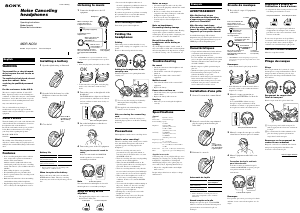


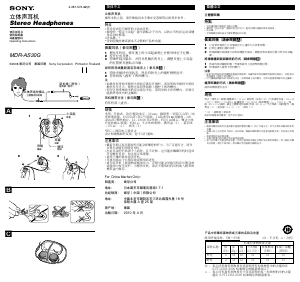
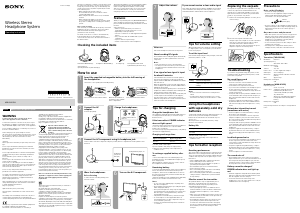


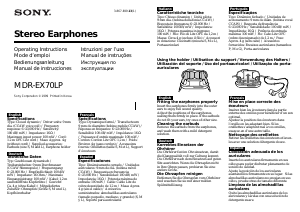
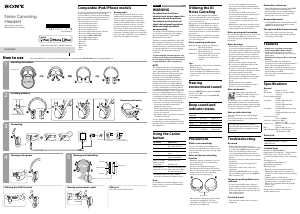
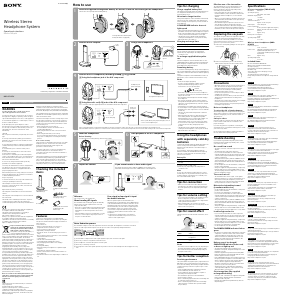
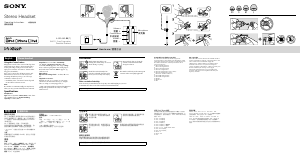
Join the conversation about this product
Here you can share what you think about the Sony MDR-NC500D Headphone. If you have a question, first carefully read the manual. Requesting a manual can be done by using our contact form.